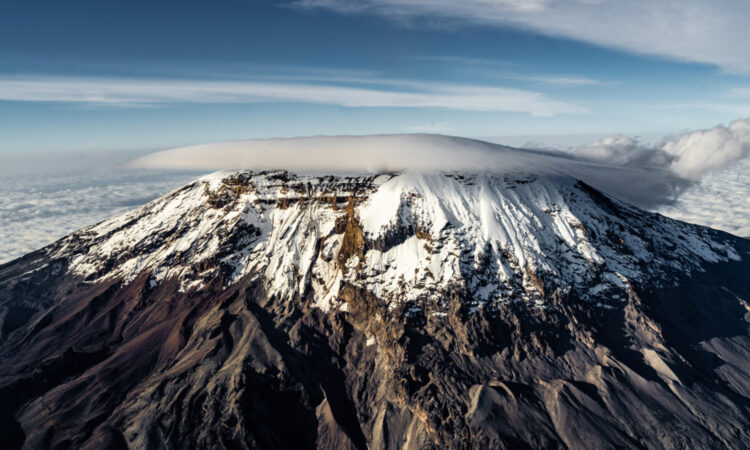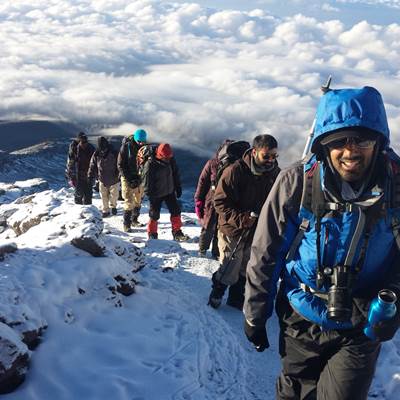Climbing Mount Kilimanjaro: Mount Kilimanjaro, the highest peak in Africa is one of the new seven wonders of the world and has a height of 5,895m or 19,341ft. Commonly referred to as the “Roof of Africa” this famous mountain is in northeastern Tanzania and considered one of the best for mountaineering. This is because apart from the height, Kilimanjaro has several climate zones that a climber has to pass through before reaching the top. From the tropical rainforest through the moorland and the alpine desert to the summit of the glaciers it truly is one of the most awe-inspiring treks in the world.

The Unique Appeal of Mount Kilimanjaro
What makes Mount Kilimanjaro to be unique is the fact that it is the tallest free-standing mountain in the world meaning its base is not part of any other mountain. This solitary giant is composed of three volcanic cones: Those are Kibo, Mawenzi, and Shira. Mawenzi and Shira are extinct while Kibo which is the highest of the three is dormant and can erupt in the future.
Due to the ease of reaching the top unlike other big mountains, many climbers and tourists have opted to climb Kilimanjaro. The climb is not a technical one and this implies that anyone who wishes to make the attempt can do so, provided the individual is fit, has the necessary determination, and has no previous climbing experience.
Choosing the Right Route
There are several approaches to climbing Mount Kilimanjaro and each of them has its own characteristics of the difficulty and the views. The selection of the route is based on the level of difficulty one wishes to undertake, the time that is to be used, and the individual’s preference. Here are the most popular routes:
- Marangu Route
Also known as the Coca-Cola Route, the Marangu Route is the most popular and perhaps the simplest way to the top. The only one that has sleeping huts instead of camping, is the only one that I really like. It usually takes 5-6 days to complete the route and the climb is considered quite moderate, thus recommended for beginners. But, the short time limit may lead to minimal exposure that the body needs to adapt to the change in altitude and hence there is a high risk of altitude sickness.
- Machame Route
Often called the ‘Whiskey Route’ the Machame Route is slightly less strenuous than the Marangu Route but is more beautiful and has a higher success rate due to proper acclimatization. This is a 6-7 day trek and the scenery is more diverse with rainforest, moorland and Alpine desert. The Machame Route is preferred by those who would want to make their climb a bit more adventurous and involve camping through the night.
- Lemosho Route
The Lemosho route is the most beautiful and least crowded route. It is a longer route and normally it takes 7-8 days and this is to enable proper acclimatization. This route begins from the western side of the mountain and joins the Machame Route on the midsection of the mountain. There are various terrains such as dense forests and beautiful sceneries of the plains that are found around the climbing area.
- Rongai Route
The only route that ascends Kilimanjaro from the north region, close to the Kenyan border is the Rongai Route. It is less crowded and gives a different view of the mountain which is quite interesting. This one is a 6-7 day trek and is relatively less strenuous since the climb is gradual. It is ideal during the rainy season as the northern side of the house gets the least exposure to rain.
- Northern Circuit Route
The Northern Circuit is the longest and the newest one which takes 9-10 days to cover. It provides a panoramic view of the mountain and this is one of the least crowded trails. This route is the most favorable for acclimatization because it takes more time, thus the probability of making it to the top is high.
Preparing for the Climb
Climbing Mount Kilimanjaro is not an easy task hence, one has to prepare for it in the right way. Here are some key considerations for prospective climbers:

Physical Fitness
However, Kilimanjaro doesn’t demand sharp climbing skills; however, it is recommended that the climber should be physically fit. Cardiovascular exercises that are recommended include hiking, running, or cycling as climber should seek to build their cardiovascular endurance. Cardiovascular exercises are also effective; however, strength training, especially in the lower body and the abs, is also effective.
Altitude Acclimatization
Acute mountain sickness is a frequent problem among climbers and the highest point of the Kilimanjaro is a serious altitude. In order to minimize the risk, one must select a route that would enable a slow increase in altitude and adhere to the ‘climb high, sleep low’ rule which entails escalating to higher altitudes in the day and descending to lower altitudes at night.
Gear and Clothing
It is vital to have the right equipment when climbing since it determines the success of the activity. This includes; multiple jackets for different weather conditions, good quality boots for hiking, a warm sleeping bag, and walking sticks. The climbers should expect the change in temperature from very hot at the bottom to very cold at the top.
Hydration and Nutrition
It is advisable to take a lot of water because the high altitude together with the physical activities may make one lose a lot of water. Climbers must take enough water and Recommended Foods That Give You Energy to have enough energy to climb.
The Climbing Experience
It is a very strenuous trek and the climb up Mount Kilimanjaro can be life-changing for many people. Usually, the climb starts with a walk in the rainforest, where one can meet such animals as monkeys and birds. The higher the climbers go, the terrain becomes quite different, first turning into the moor, and then into the alpine desert.
The last and the most difficult part of the climb is the summit assault in which climbers start climbing at midnight to get to the top by the time the sun rises. It is the final and the toughest part of the climb that is known as summit push; it involves a steep and tiring ascent over the scree and the loose rocks. The sharp and low temperatures also don’t help, but the view of the sun that rises over the African savanna from the top – Uhuru Peak – is a beautiful motivation.
The Impact of Climbing Kilimanjaro
Despite the fact that climbing Kilimanjaro is such a great experience, one cannot ignore the effects that tourism has on the mountain and the people living around it. Littering is strictly prohibited and climbers are asked to adhere to the Leave No Trace principles; this means that one should carry all their trash and respect wildlife and geology.
Also, it is important to promote ethical tour operators that ensure that the guides and porters are well-remunerated and have decent working conditions. The Kilimanjaro Porters Assistance Project (KPAP) is a non-governmental organization that addresses the issue of the treatment of the porters as well as the payment they get while working on Kilimanjaro.
Conclusion
It is a task that is exciting, fascinating, thrilling, and rather challenging as one gets to climb the highest peak of Africa, Mount Kilimanjaro. Kilimanjaro can be climbed for the fun of it, for the scenery, or for the sense of accomplishment, and thus everyone who wants to climb it should. When properly prepared and with passion, one is sure to have a great challenge climbing this giant mountain.


